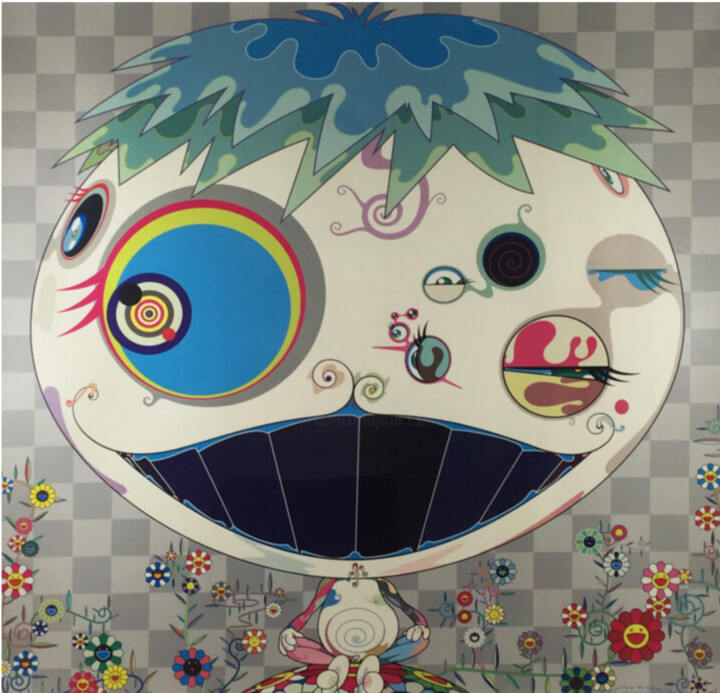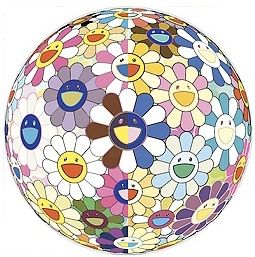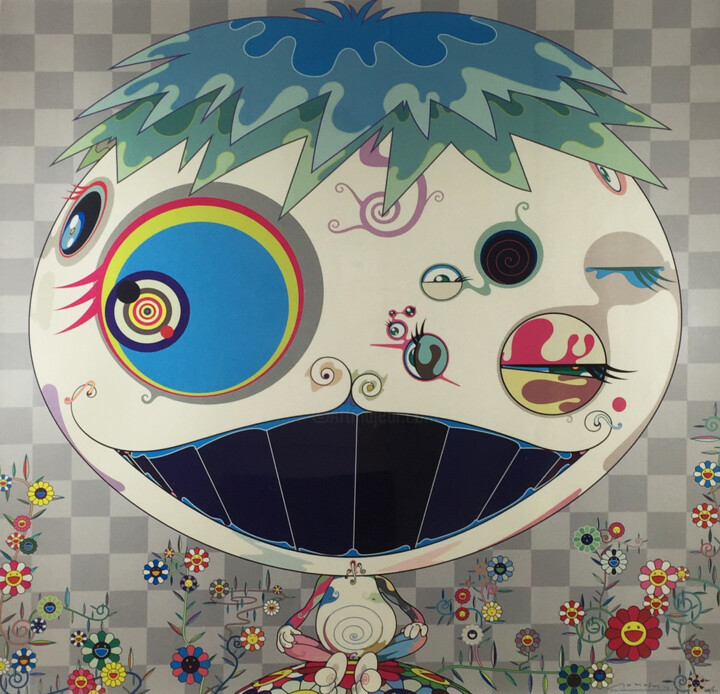Takashi Murakami (born February 1, 1962) is a renowned Japanese contemporary artist celebrated for his work in both fine arts and commercial media. His artistic practice includes painting, sculpture, fashion, merchandise, and animation, and he is particularly known for blurring the boundaries between high and low art. Murakami's work is heavily influenced by the aesthetic traditions of Japan and the country's postwar culture. Notable achievements in Murakami's career include designing album covers for Kanye West's "Graduation" and the collaborative album "Kids See Ghosts" by Kanye West and Kid Cudi. He is also the founder and President of Kaikai Kiki Co., Ltd., an art management company that supports emerging artists. Additionally, Murakami founded and organized the biannual art fair Geisai, further contributing to the contemporary art scene.
Artist Biography: Takashi Murakami
Takashi Murakami, born and raised in Tokyo, Japan, developed an early interest in anime and manga, initially aspiring to work in animation. He attended Tokyo University of the Arts, majoring in Nihonga, a traditional Japanese painting style. Despite earning a master's degree in 1988 and a Ph.D. in 1993, Murakami became disillusioned with Nihonga's insularity and began exploring contemporary artistic styles. His early works, characterized by social criticism and satire, include the controversial sculpture My Lonesome Cowboy, which sold for $15.1 million at Sotheby’s in 2008. In 1994, Murakami received a fellowship from the Asian Cultural Council and participated in the PS1 International Studio Program in New York City, where he was influenced by Western contemporary artists like Jeff Koons. He established a small studio, which later evolved into Kaikai Kiki Co., Ltd. Murakami's "Superflat" theory, introduced in 2000, posits that the flat, two-dimensional imagery in Japanese art history persists in manga and anime, reflecting a postwar Japanese society where distinctions between high and low culture have blurred.
Murakami launched the Hiropon Factory in 1996 to work on a larger scale and diversify his media. The factory was later incorporated as Kaikai Kiki Co., Ltd. His collaboration with Louis Vuitton in 2002, initiated by designer Marc Jacobs, was a commercial success and made Murakami widely known for blending high art with commercialism. He continued to straddle the line between art and commerce, collaborating with various creators and industries, including providing cover art for Kanye West’s albums "Graduation" and "Kids See Ghosts." Murakami's first retrospective, ©Murakami, traveled internationally from 2007 to 2009, earning widespread attention. In 2008, he was named one of Time magazine's "100 Most Influential People." He became the first Japanese contemporary artist to exhibit at the Palace of Versailles in 2010. His influence extended to popular culture, with collaborations ranging from Pharrell Williams to Billie Eilish and fashion designer Virgil Abloh. Murakami's art, generally described as superflat, spans a wide range of media and is noted for its vibrant use of color, incorporation of motifs from Japanese traditional and popular culture, flat and glossy surfaces, and content that can be simultaneously "cute," "psychedelic," and "satirical." His best-known recurring motifs include smiling flowers, Mr. DOB, mushrooms, skulls, Buddhist iconography, and the sexual complexes of otaku culture. Notably, his sculpture Hiropon exemplifies his embrace of otaku culture and its shocking sexuality. The concept of his smiling flowers, as revealed in an interview, evokes repressed emotions and collective trauma from the Hiroshima and Nagasaki bombings.
Murakami's oeuvre includes large paintings such as 727 (permanent collection at the Museum of Modern Art, New York) and Tan Tan Bo Puking – a.k.a. Gero Tan, as well as sculptures, balloons, wallpaper installations, animated works, prints, posters, and assorted merchandise. Frustrated by the lack of a reliable art market in postwar Japan, Murakami sought to establish himself in the Western art world and then reintroduce himself to Japan, aiming to build a new type of art market. His artistic style and motifs—cute yet disturbing anime-esque characters rendered in bright colors and glossy surfaces—reflect his focus on Japan's low culture, particularly anime, manga, and the otaku subculture. This strategy is demonstrated in whimsical pieces like Cosmos Ball (2000), part of the Honolulu Museum of Art's collection.
Superflat
Superflat, initiated by Takashi Murakami, is a postmodern art movement deeply rooted in manga and anime influences, though intentionally left open-ended to evolve organically. Originating from Murakami's 2000 curated exhibition that traveled through West Hollywood, Minneapolis, and Seattle, Superflat critiques the perceived shallowness of Japanese consumer culture through various flattened forms across graphic art, animation, and fine arts. This concept has also inspired a hybrid style known as "SoFlo Superflat" among American artists. Themes within Superflat range widely, from explorations of post-war Japanese consumerism and sexual fetishism, exemplified by artists like Henmaru Machino, to playful critiques of societal norms and fears of maturity, such as Yoshitomo Nara's reinterpretations of traditional ukiyo-e. Murakami extends Superflat to encompass historical Japanese art, drawing parallels with Edo period painters like Hokusai, influenced by art historian Nobuo Tsuji's analysis of gaze dynamics. This movement bridges traditional Japanese aesthetics with contemporary influences, exploring themes of otaku culture and societal critique amidst economic uncertainties in 1990s Japan, as articulated by curator Michael Darling.
Jelly Fish (2003) by Takashi Murakami
Takashi Murakami, Jelly Fish, 2003. Printmaking, Lithography on Paper, 68cm x 68cm.
In Takashi Murakami's 2003 offset lithographic print titled Jelly Fish, the artwork features a central jellyfish character with large, expressive eyes, situated on a fantastical, flower-covered planet. The jellyfish commands attention with its anthropomorphic gaze, exuding a sense of peace and serenity amidst the vibrant floral surroundings typical of Murakami's playful aesthetic. The flowers depicted are stylized and brightly colored, embodying a whimsical and joyful atmosphere that characterizes Murakami's fantasy worlds. This limited edition print, number 258 out of 300, showcases Murakami's signature use of flowers as symbols of beauty and nature, illustrating his unique blend of pop culture influences and traditional Japanese artistic motifs. The composition not only captivates with its dynamic colors and patterns but also invites viewers into Murakami's imaginative realm where surrealism meets vibrant exuberance.
Reversal DNA, (2001) by Takashi Murakami
Takashi Murakami, Reversal DNA, 2001. Printmaking, Lithography on Paper, 54 x 54 cm.
Reversal DNA is a 2001 offset lithographic print by Takashi Murakami, featuring two of his iconic characters, "Mr. Dob." These figures are known for their playful and cute appearance, characterized by large round eyes and cheerful smiles. In this artwork, the two "Mr. Dob" characters are likely depicted in a colorful and dynamic setting typical of Murakami's style. The offset lithographic printing technique faithfully reproduces the original artwork's details and colors, maintaining the vibrancy and intricacies of Murakami's creation. Each print in this limited edition, numbered 299 out of 300, bears the artist's signature, adding to its value as a sought-after collector's item. "Mr. Dob" has become a symbol synonymous with Murakami's artistry, symbolizing his unique blend of pop culture influences and Japanese tradition. Despite slight damage with faded color along the edges, "Reversal DNA" remains a vibrant representation of Murakami's joyful and playful aesthetic.
Iconic Artwork
Takashi Murakami, a luminary in contemporary art blending pop culture, anime, and traditional Japanese influences, is renowned for a prolific body of work that challenges artistic norms. His artworks span from the monumental Chaos completed in 2007 in Tokyo—a psychedelic explosion of color akin to a joyous paintball frenzy—to the exuberant Flower Ball (2002) in New York, a vibrant celebration of blooms in playful, crazy colors. Murakami's whimsical Army of Mushrooms from 2003 in Hiroshima depicts an adorable, whimsical invasion of mushroom characters, while Eye Love Superflat (2001) from Tokyo offers a playful optical illusion with oversized winking eyes. His collaboration with Supreme resulted in the globally scattered Supreme Skate Decks (2007), transforming skateboards into dynamic canvases of motion and artistry. Mushroom Youkai (2000) in Los Angeles invites viewers into a magical woodland realm inhabited by mischievous mushrooms, while 727 (1996) from New York nostalgically blends historical Japanese art with contemporary anime. Jellyfish Eyes (2001) from Tokyo transports viewers to an underwater disco of groovy, eye-adorned jellyfish, and Mister Wink, Cosmos Ball (2000) in New York guides audiences through an intergalactic adventure of cosmic whimsy. Murakami's !N-Cha! (2001) from Tokyo bursts with celebratory energy, while Tan Tan Bo (2001) in Los Angeles spans three gold canvases with his iconic character Mr. DOB amidst smiling flowers. Flower Matango (2001) from Tokyo presents a psychedelic dance of flowers and mushrooms, celebrating life and nature in Murakami's distinctive style, and Blackbeard (2012) in New York adds an enigmatic touch contrasting darkness with vibrancy in his artistic universe.
Exhibition History and Art Market
Takashi Murakami’s exhibition history reflects a dynamic trajectory spanning major global art hubs and prestigious venues. His recent show, "Understanding the New Cognitive Domain" at Le Bourget from June 10 to December 22, 2023, highlighted his exploration of contemporary themes through vibrant canvases blending traditional and pop culture influences. Earlier, "GYATEI²" in Beverly Hills from February 21 to April 13, 2019, and "AMERICA TOO" with Abloh in Beverly Hills from October 10 to 25, 2018, underscored his collaborative prowess and cultural impact. Murakami’s retrospective at West 21st Street, New York, from June 20 to August 22, 2008, and subsequent solo presentations in Hong Kong, London, Moscow, and Paris have consistently showcased his ability to innovate within the realms of Superflat art, seamlessly merging high and low culture influences into a cohesive visual narrative. These exhibitions not only solidify Murakami’s global stature but also emphasize his pivotal role in reshaping contemporary art discourse.
Takashi Murakami's presence in the art market is formidable, evidenced by the astronomical prices fetched by his most coveted pieces at auctions worldwide. Murakami's exploration of the Superflat style, melding traditional Japanese art with contemporary pop culture, has captivated collectors globally. His iconic character Mr. DOB features prominently in his top-selling works, with My Lonesome Cowboy, a sculpture from 1998, standing out as his highest auction achiever, selling for an astounding $13,500,000 at Sotheby’s New York in 2008. This work, encapsulating Murakami's provocative and playful approach, remains a pinnacle in contemporary art auction history. Other notable pieces include Miss Ko2 (1997), a life-size sculpture embodying otaku aesthetics, which sold for $6,000,000 at Phillips New York in 2010, and Tan Tan Bo (2001), featuring Mr. DOB across three gold canvases, achieving $4,200,000 at Christie's New York in 2018. Murakami's ability to fuse commercialism with fine art has not only redefined perceptions of contemporary Asian art but also cemented his status as one of the most sought-after artists in the Western art market.
Takashi Murakami's impact on the global art market is undeniable, reflected in the staggering prices his artworks command at prestigious auctions worldwide. Renowned for his innovative Superflat style that merges traditional Japanese art with contemporary pop culture, Murakami's creations captivate collectors with their vibrant colors and whimsical characters. His sculpture "My Lonesome Cowboy," sold for a record-breaking $13,500,000 at Sotheby’s New York in 2008, stands as a testament to his provocative artistic vision. Similarly, "Miss Ko2," embodying otaku aesthetics, fetched $6,000,000 at Phillips New York in 2010, while "Tan Tan Bo," featuring his iconic Mr. DOB, achieved $4,200,000 at Christie's New York in 2018. Murakami's ability to blur the lines between high art and commercialism has not only reshaped contemporary Asian art but also elevated him to a revered position in the Western art world, solidifying his influence and enduring appeal.




 Selena Mattei
Selena Mattei






